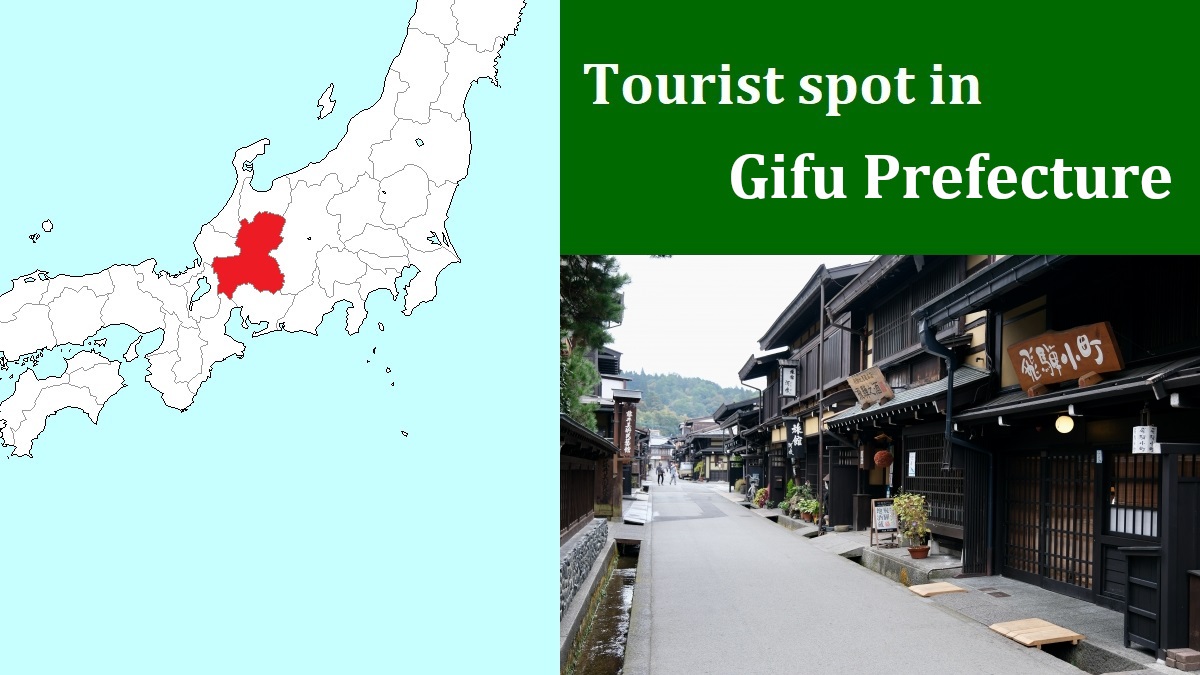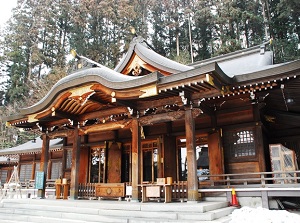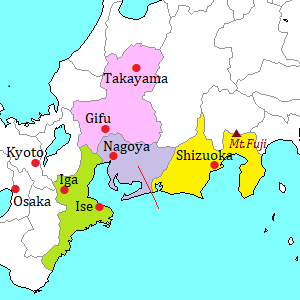Takayama city [高山]
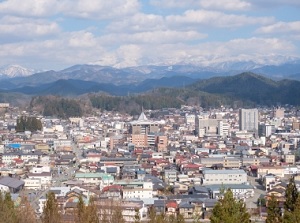
Takayama city
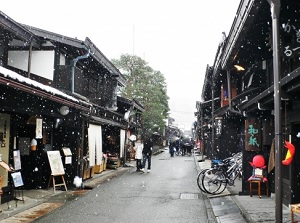
Old town of Takayama in winter
Takayama is a central city of Hida area.
It is located about 100 km north-northeast of Gifu city, and about 70 km south of Toyama city on the Sea of Japan side.
The city is about 550 meters above sea level.
Takayama has the old town since the 17th century, so it is called Little Kyoto in Hida.
Because it is the center of Hida area, the town name is often introduced as "Hida-Takayama".
There was a town in this area in ancient times.
In the 7th to 8th centuries, many Buddhist temple were built in Takayama.
Around 1600, Takayama Castle were built and the town was also constructed in a systematic manner.
Since that, Kanamori Family governed this area as the lord of the castle.
At the end of the 17th century, the lord was moved to the other region suddenly.
And Takayama became a government-ruled town.
Takayama Castle was demolished and an office of Edo Government was set up instead.
(It is Takayama Jin-ya.)
Therefore, Takayama became the town of common people rather than samurai.
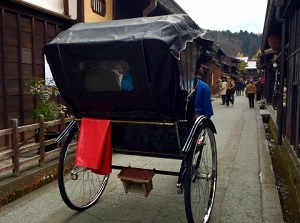
Rickshaw for tourist in Takayama
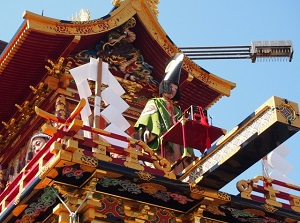
Karakuri on a float in Takayama Festival
Rich marchants created the gorgeous cultures such as Takayama Festival.
On the other hand, they had been moderate, so they built many buidings with calm feeling.
Fortunately, the old town has been kept the atmosphere of the old time because there has been no large natural disaster and war damage.
Takayama Festival is one of famous festivals in Japan.
It is held on April 14, 15 and October 9, 10 as each annual festivel of two Shinto Shrines in Takayama.
About a dozen beautiful and gorgeous floats are pulled throughout the city.
Hundreds of thousands of people visit for the festival in the period every year.
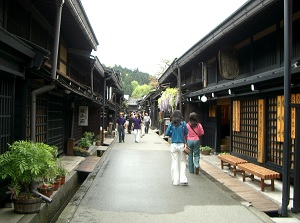
Old town of Takayama in spring
Photo by Takayama City
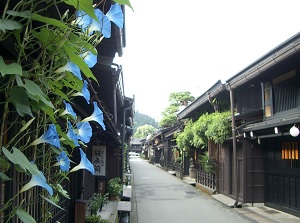
Old town of Takayama in summer
Photo by Takayama City
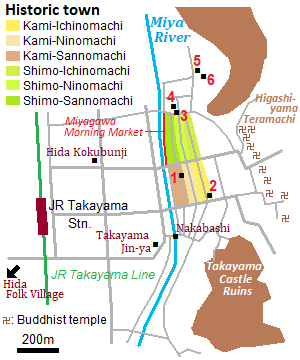
1) Fujii Art Museum 2) Museum of History and Art
3) Kusakabe Folk Museum 4) Toshijima Residence
5) Yatai Kaikan 6) Karakuri Museum
Miya River (宮川, Miyagawa in Japanese) flows through the city from south to north.
The historic town is on the east side.
On the west of the river, there is the new town and JR Takayama station.
The historic town is about 500 meters from north to south and about 200 meters from east to west in width.
Three main streets run parallel from north to south.
The names of the districts along the streets are Ichinomachi (一之町, 1st town), Ninomachi (二之町, 2nd town) and Sannomachi (三之町, 3rd town) from the west.
In addition, the name of southern half part has a prefix "Kami" (上) such as "Kami-Ichinomachi", and the name of northern half part has a prefix "Shimo" (下) such as "Shimo-Niomachi".
In summary, six districts are in the old town.
The whole districts are called Sanchô (三町, meaning "Tree towns").
The district with the most historic buildings is Kami-Sannomachi near Miya River.
Most of the houses in Sancho are marchant's residences.
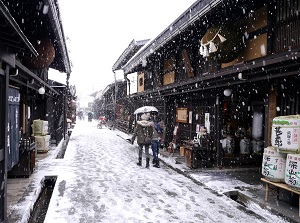
Old town of Takayama in winter
Photo by Takayama City
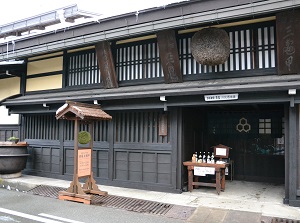
Sake brewery in Takayama
Photo by Takayama City
And there are several Sake breweries in this area.
The sign of Sake breweries is a ball made of leaves of Japanese cedar hung under the eaves.
When new sake has been made, new ball is hung.
Of course, the color is green and it turns brown gradually.
It shows the maturity of the sake.
From the middle of January to the end of February, one of six breweries opens its own brewing rooms to the visitors in turns.
Of course, we can enjoy the tasting of new sake.
A few breweries have the English website.
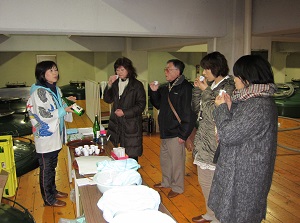
Sake tasting event in winter
Photo by Takayama City
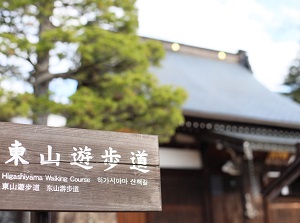
Higashiyama walking course
Photo by Takayama City
There are hills to the northeast and southeast of the town.
Takayama Castle was on the southeast hill.
And about a dozen Buddhist temples line between the hills.
They were built to the east of the main area like Higashiyama in Kyoto.
So the district is called Higashiyama Teramachi (東山寺町).
To tour around the historic area, walking or rental bicycle is enough.
Taking a sightseeing rickshaw is also a good idea.
But it is expensive a little. (4,000 to 20,000 yen per 15 to 60 minutes (2 or 3 seats))
Route bus in old town runs about once per an hour.
"Machinami Bus" is available to visit surrounding area of Takayama.
Main spots near Miya River
There are several bridges over Miya River.
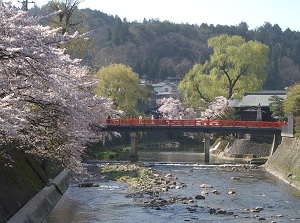
Nakabashi in spring
Photo by Takayama City

Nakabashi in autumn
Photo by Takayama City
Nakabashi (中橋) is the most popular bridge, and is located to the southwest of Sancho area.
Beautiful floats are pulled on this bridge in Takayama Festival, and the scene is well-known.
So this is a symbol of Takayama.
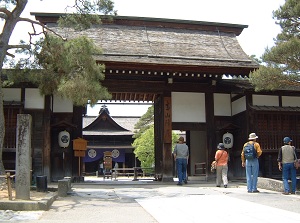
Gate of Takayama Jin-ya
Photo by Takayama City
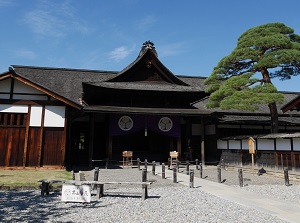
Takayama Jin-ya
Photo by Takayama City
There is Takayama Jin-ya (高山陣屋) to the west of Nakabashi.
It was the office of Edo Government.
It was built in the late 17th century, and was rebuilt in 1816.
And it had been used as an office of Gifu Prefecture until 1969.
Now it is opened to the public and the visitors can see the inside.
Morning Market
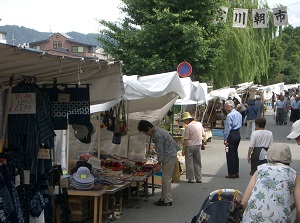
Miyagawa Morning Market
Photo by Takayama City
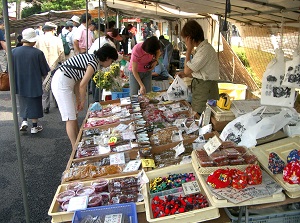
Jin-ya-mae Morning Market
Photo by Takayama City
Morning market in Takayame has been well-known.
On the street along Miya River to the west of Shimo-Sannomachi, Miyagawa Morning Market (宮川朝市) is opened in the morning every day.
And Jin-ya-mae Morning Market (陣屋前朝市) is opened around the gate of Takayama Jin-ya.
Morning market had been opened since the 17th century.
Current morning market along Miya River was started in 1953.
Dozens of stalls sell vegetables, fruits, pickles, flowers or folk crafts.
They are opened from 7:00 to 12:00 from April to October, and from 8:00 to 12:00 from November to March.
Some sightseeing spots in Sancho area
In Sancho, there are some museums.
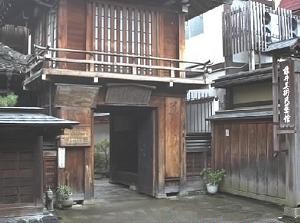
Fujii Art Museum
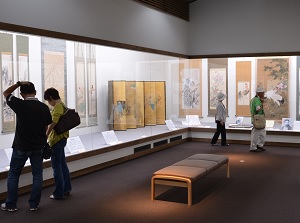
Takayama Museum of History and Art
Photo by Takayama City
Fujii Art Museum (藤井美術民芸館) is in Kami-Sannomachi and the gate is like castle gate.
About 2,500 old hanging scrolls, potteries, etc. collected by a medical doctor are displayed.
Takayama Museum of History and Art (飛騨高山まちの博物館) is in Kami-Ichinomachi.
The building was a storehouse built in 1875, and various historic articles in Hida area are displayed.
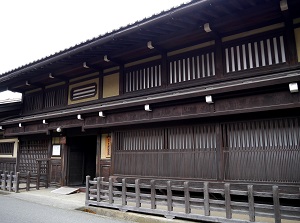
Kusakabe Folk Museum
Photo by Takayama City
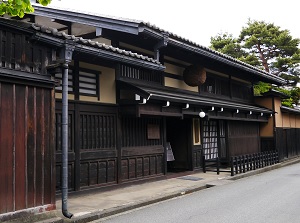
Yoshijima Residence
Photo by Takayama City
Kusakabe Folk Museum (日下部民藝館) is located to the north of Sancho area.
The building is the old residence of Kusakabe family rebuilt in 1879 after the great city fire.
Kusakabe family was one of the wealthy merchants.
The livingwares in that times are displyed.
Yoshijima Residence (吉島家住宅) is next to Kusakabe Folk Museum and was a former merchant residence.
The building was a sake brewery.
It was destroyed by fire in 1875, and the current residence was rebuilt in 1907.
Takayama Festival Floats Exhibition Hall (高山祭屋台会館)
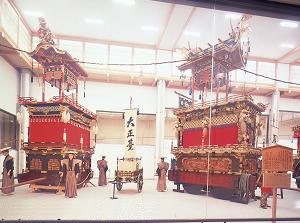
Takayama-matsuri Yatai Kaikan
Photo by Gifu Prefecture Tourist Federation
Takayama Festival Floats Exhibition Hall is the museum of the gorgeous floats using in Takayama Festival. ("Takayama-matsuri Yatai Kaikan" in Japanese)
It is located about 300 meters north of Sancho area.
It is in the precincts of Sakurayama Hachimangu shrine (櫻山八幡宮).
Takayama Festival in October is the annual festival of Sakurayama Hachimangu.
In this museum, there are real floats using in Takayama festival.
Usually, four of them are exhibited by rotation.
Karakuri Museum (からくりミュージアム)
Karakuri Museum is a museum introducing Japanese "Karakuri", and is located near Takayama Yatai Kaikan.
Karakuri is traditional Japanese mechanized puppet or automaton, and it makes magical motions.
It had made with traditional method since the 17th century.
The karakuris are set up on a few floats of Takayama Festival and the magical show is a highlight of the festival.
In this museum, you can enjoy the show of some karakuris.
Hida Kokubunji (飛騨国分寺)
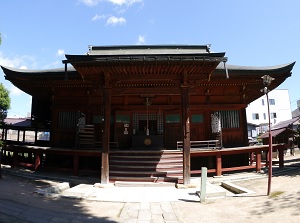
Main temple of Hida Kokubunji
Photo by Takayama City
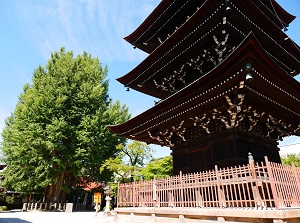
Three-storied pagoda & ginkgo tree
Photo by Takayama City
Hida Kokubunji is a Buddhist temple of Shingon Buddhism which is one of a major Japanese Buddhism.
"Kokubunji" was built in each area in Japan by order of Emperor Shomu in 741.
It is said that this temple was founded as one of Kokubunji temples by high priest Gyoki in 757.
The temple had been rebuilt after the destruction by fire several times.
The main temple was built around the 15th century, and it is said that the Buddha statues enshrining in this temple was created around the 11th century.
It is said that the original pagoda in this temple had seven stories.
But it was rebuilt as three-storied pagoda in 1820.
There is a big ginkgo tree in front of the three-storied pagoda.
A legend about the tree is told.
A master-carpenter was constructing the seven-storied pagoda for new Kokubunji.
But, he had made a fatal mistake when cutting the main timbers.
Because the work was very important, he became depressed.
After that, his daugher proposed a good idea for recovery to him.
He adopt the idea, and very excellent pagoda was completed.
But, he killed his daughter to hide his failure.
He buried her dead body near the pagoda and planted a ginkgo tree.
It is exactly the ginkgo tree.
It is said that the tree is over 1,250 years old and the height is about 37 meters.
In relation to the legend, this tree has some parts like female breast.
If your breast produces little milk and you worship this tree, it is said that it will produce much milk.
The tree was designated as a national natural treasure.
Hida Folk Village (飛騨民俗村)
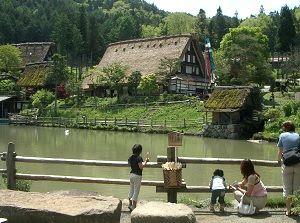
Hida Folk Village
Photo by Takayama City
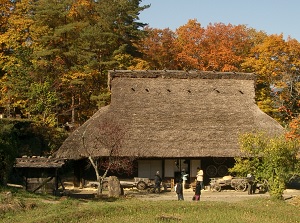
Hida Folk Village in autumn
Photo by Takayama City
Hida Folk Village is an open-air museum located about 2 km southwest of JR Takayama station.
The popular name is Hida no Sato meaning "Village of Hida".
About 30 old farm houses has been removed here.
Most of them were built in various village in Hida area in the 19th century, and were designated as the national important cultural properties.
And traditional weaving and producing of artcrafts are demonstrated in the houses.
How to get here
From Nagoya, by limited express of JR Takayama Line, about 2.5 hours.
Or, by express bus, about 2.5 hours from Nagoya, about 5.5 hours from Osaka, about 5.5 hours from Tokyo.

